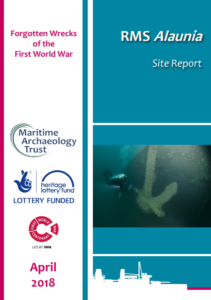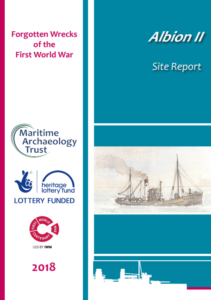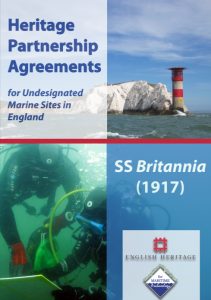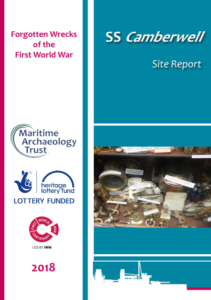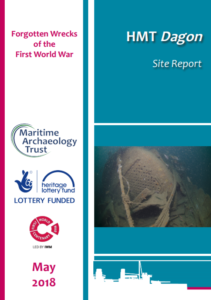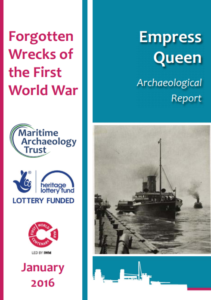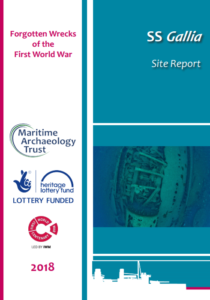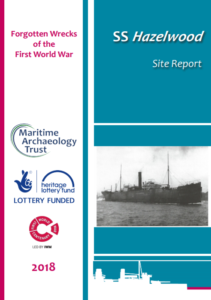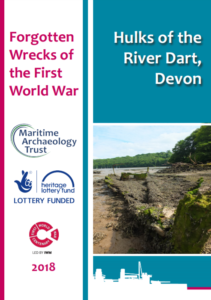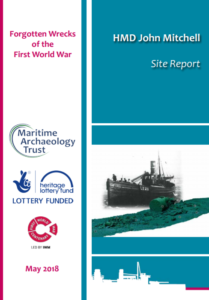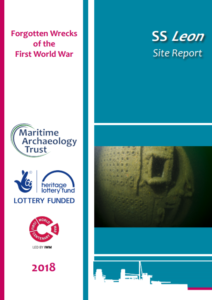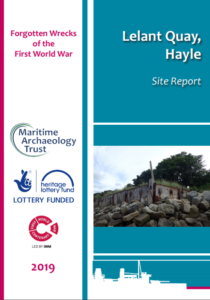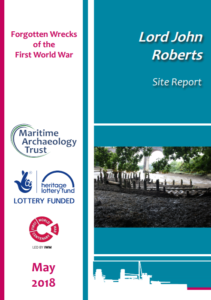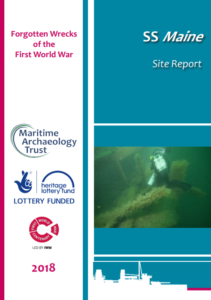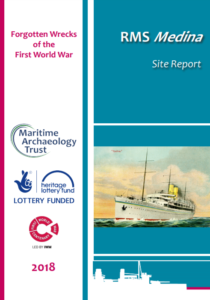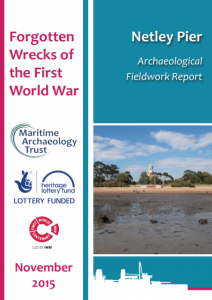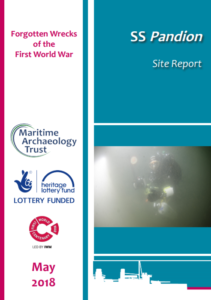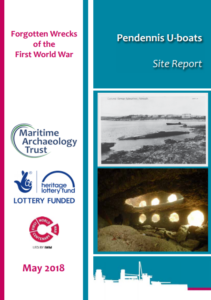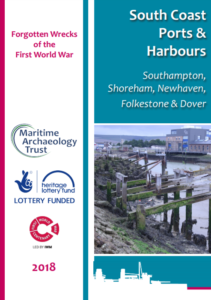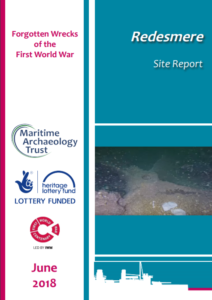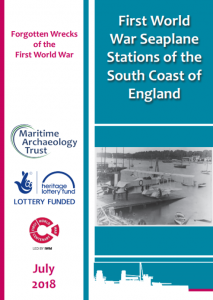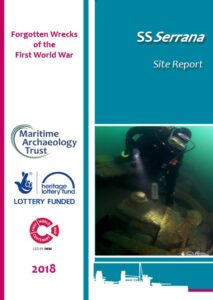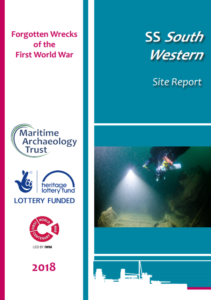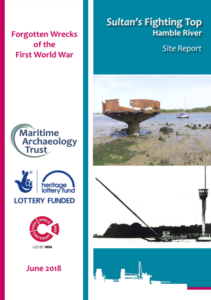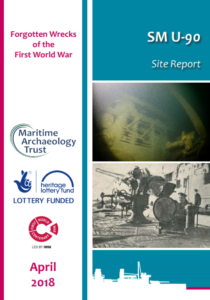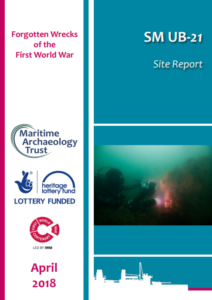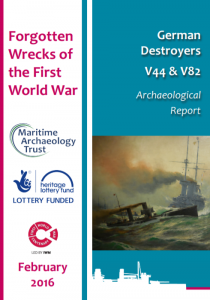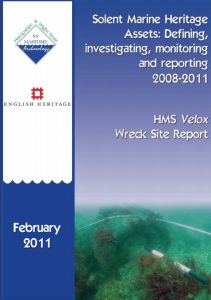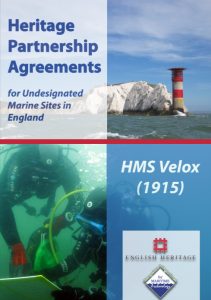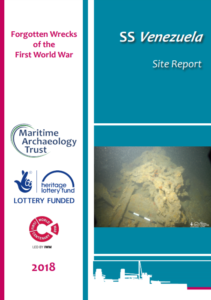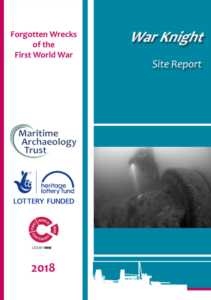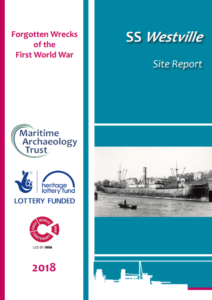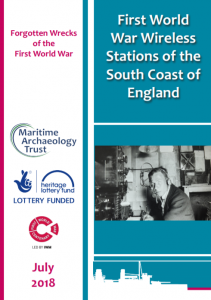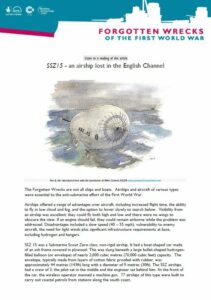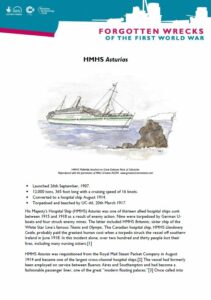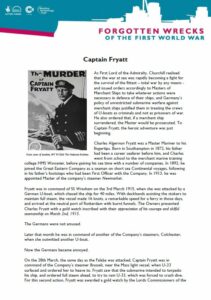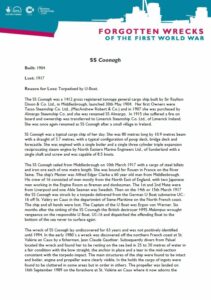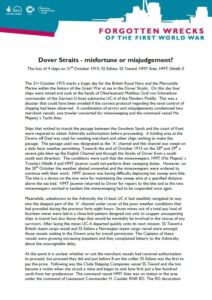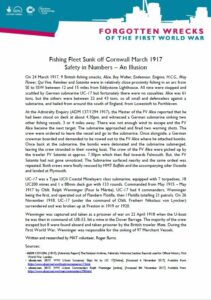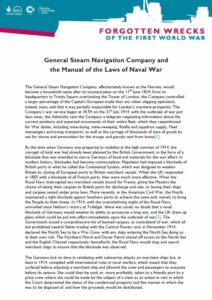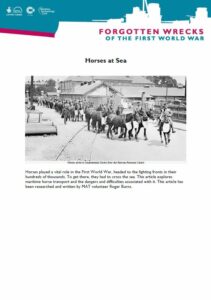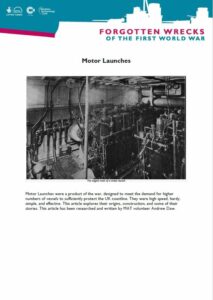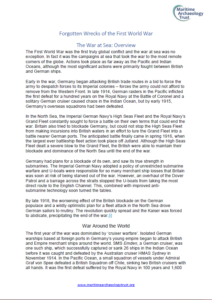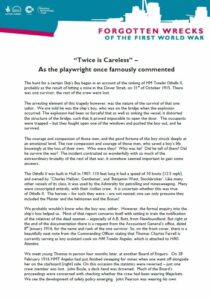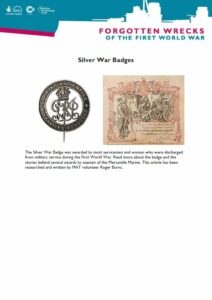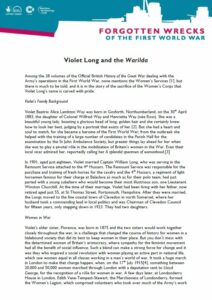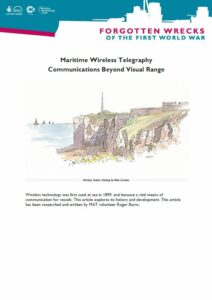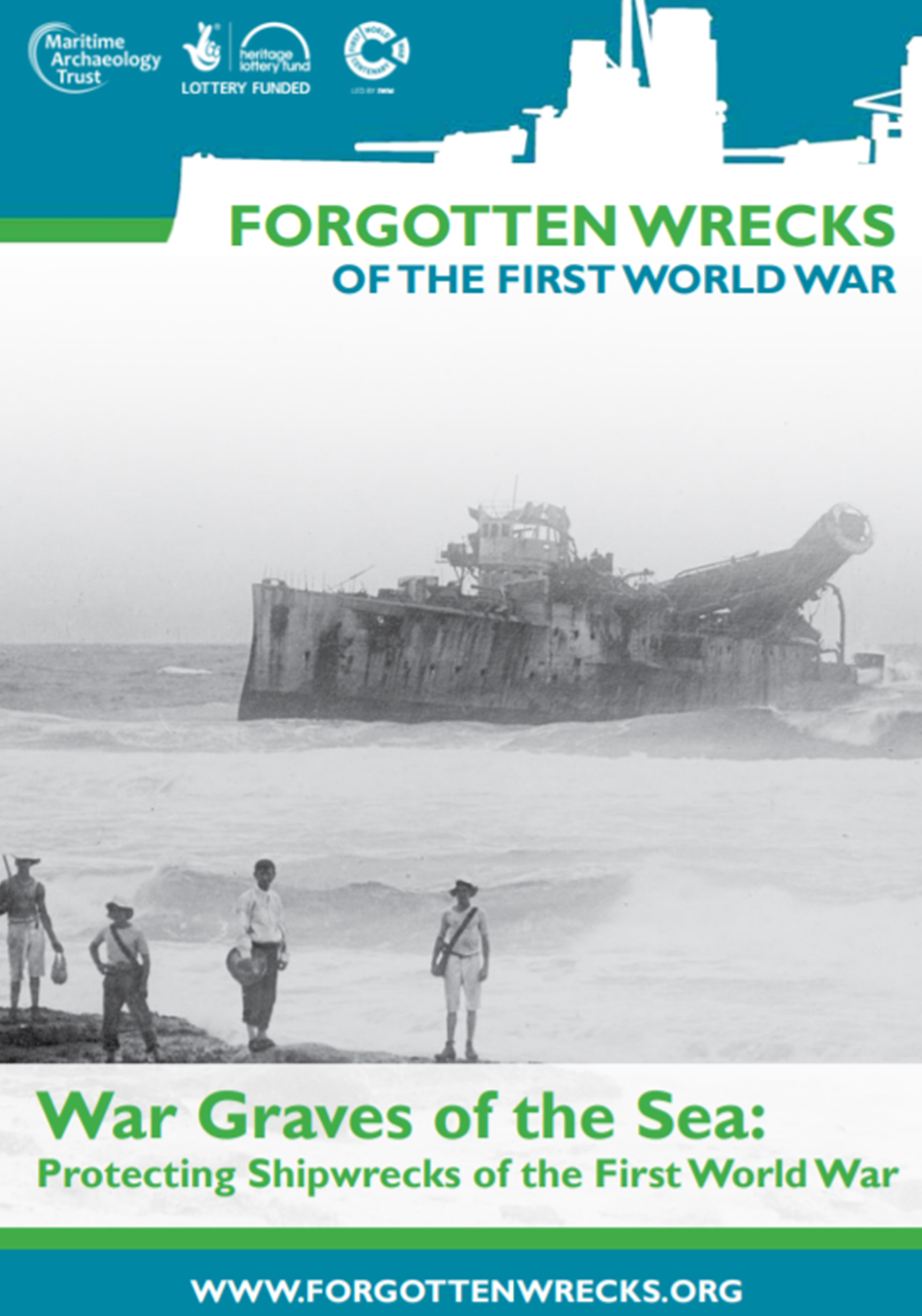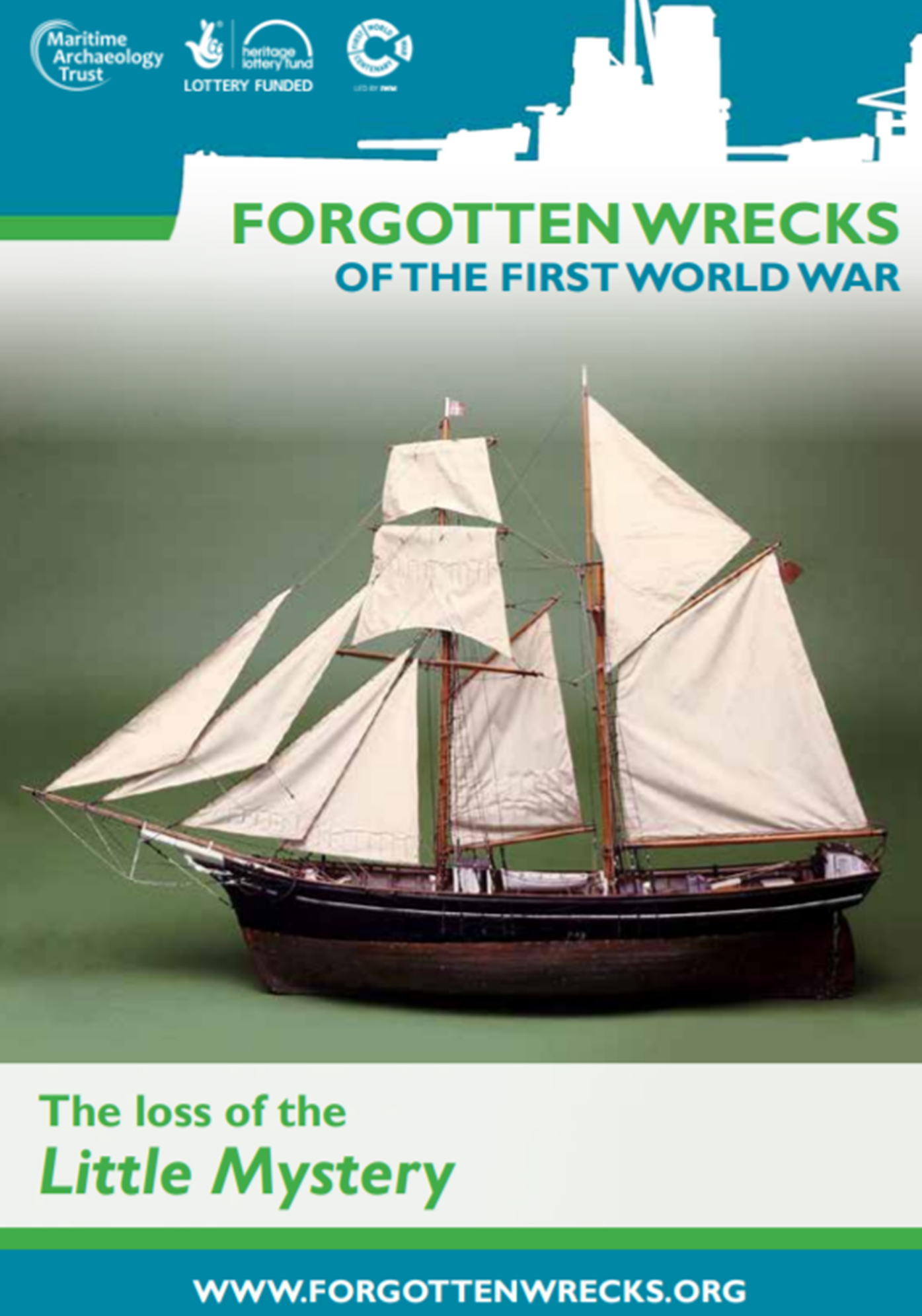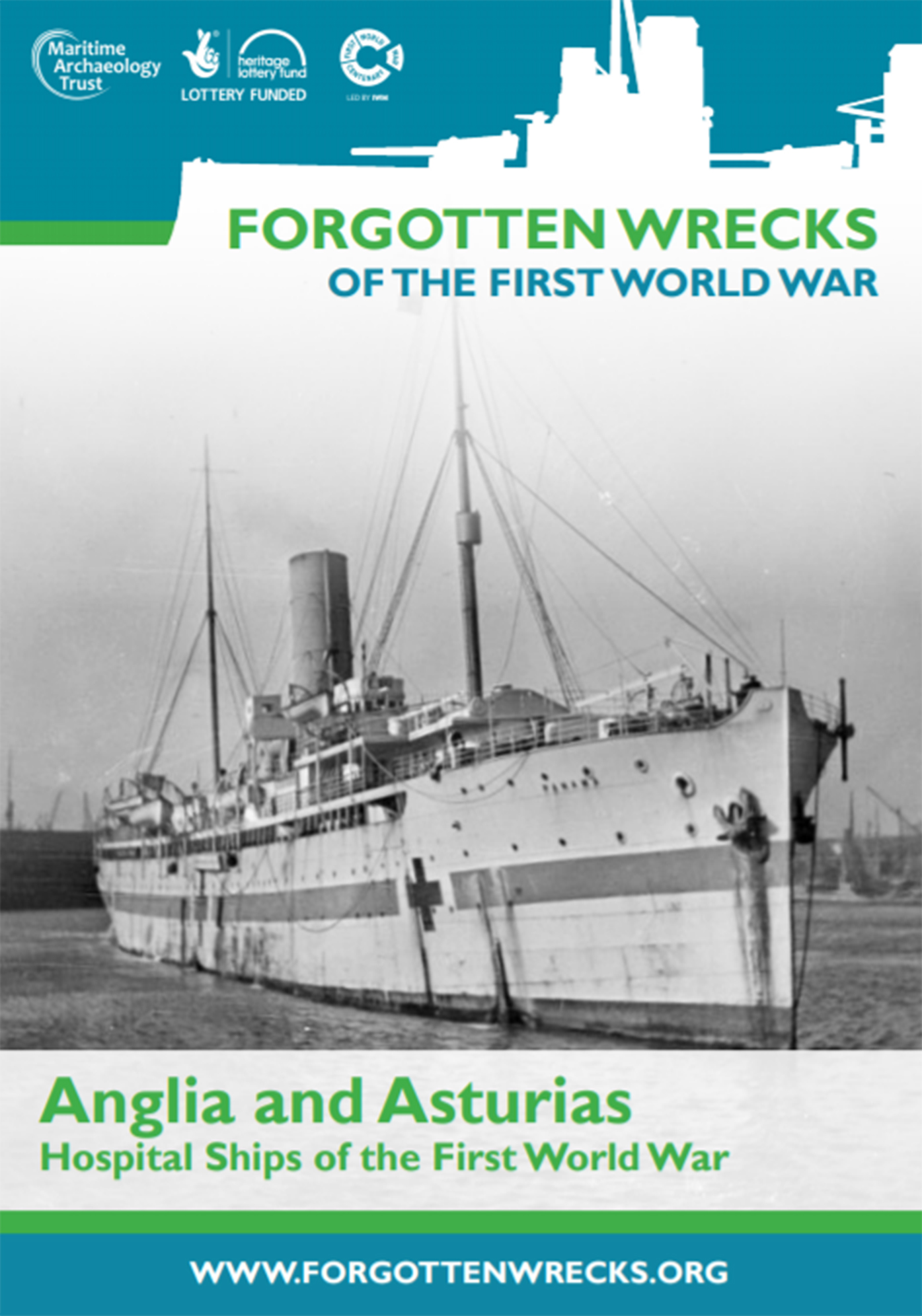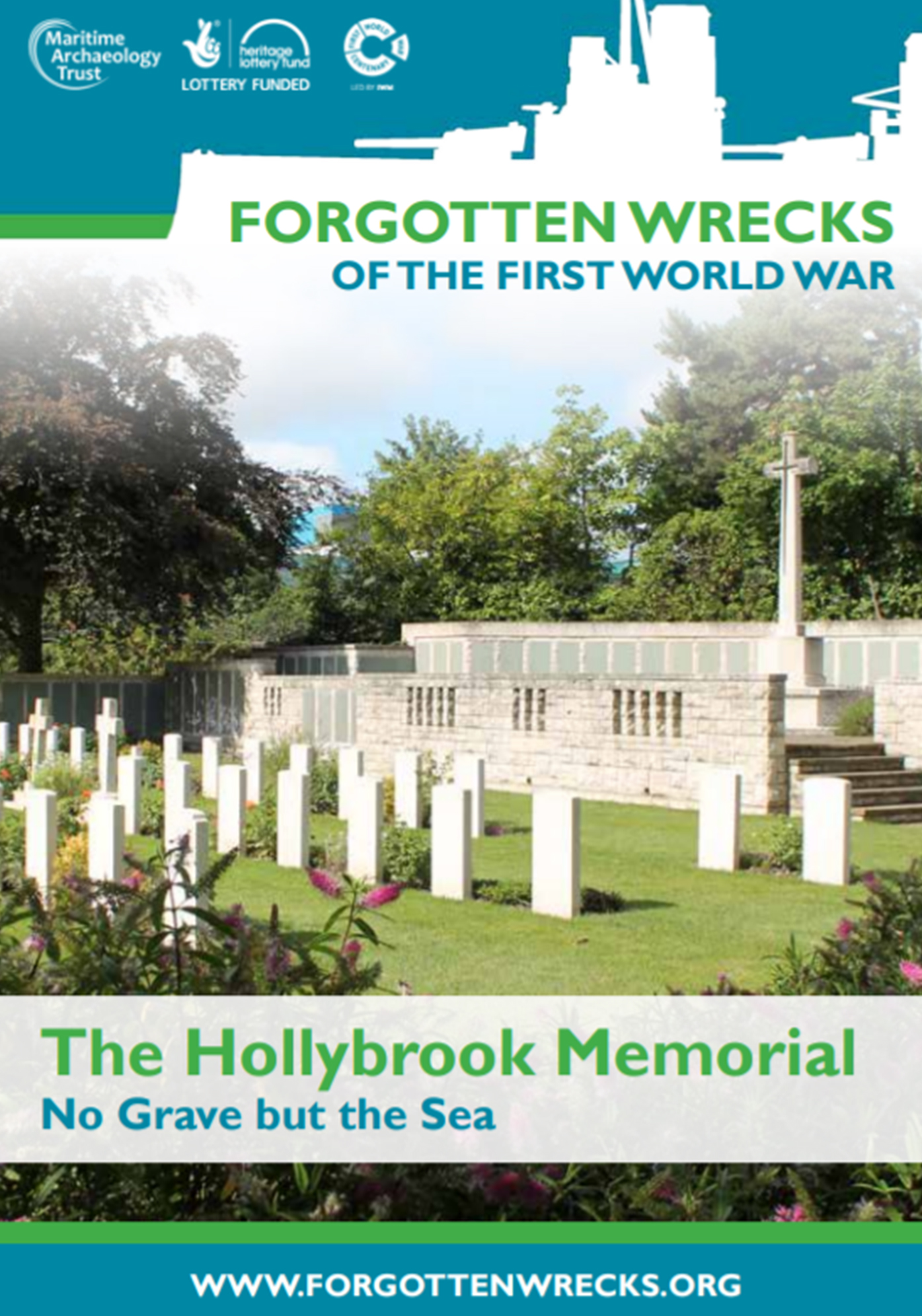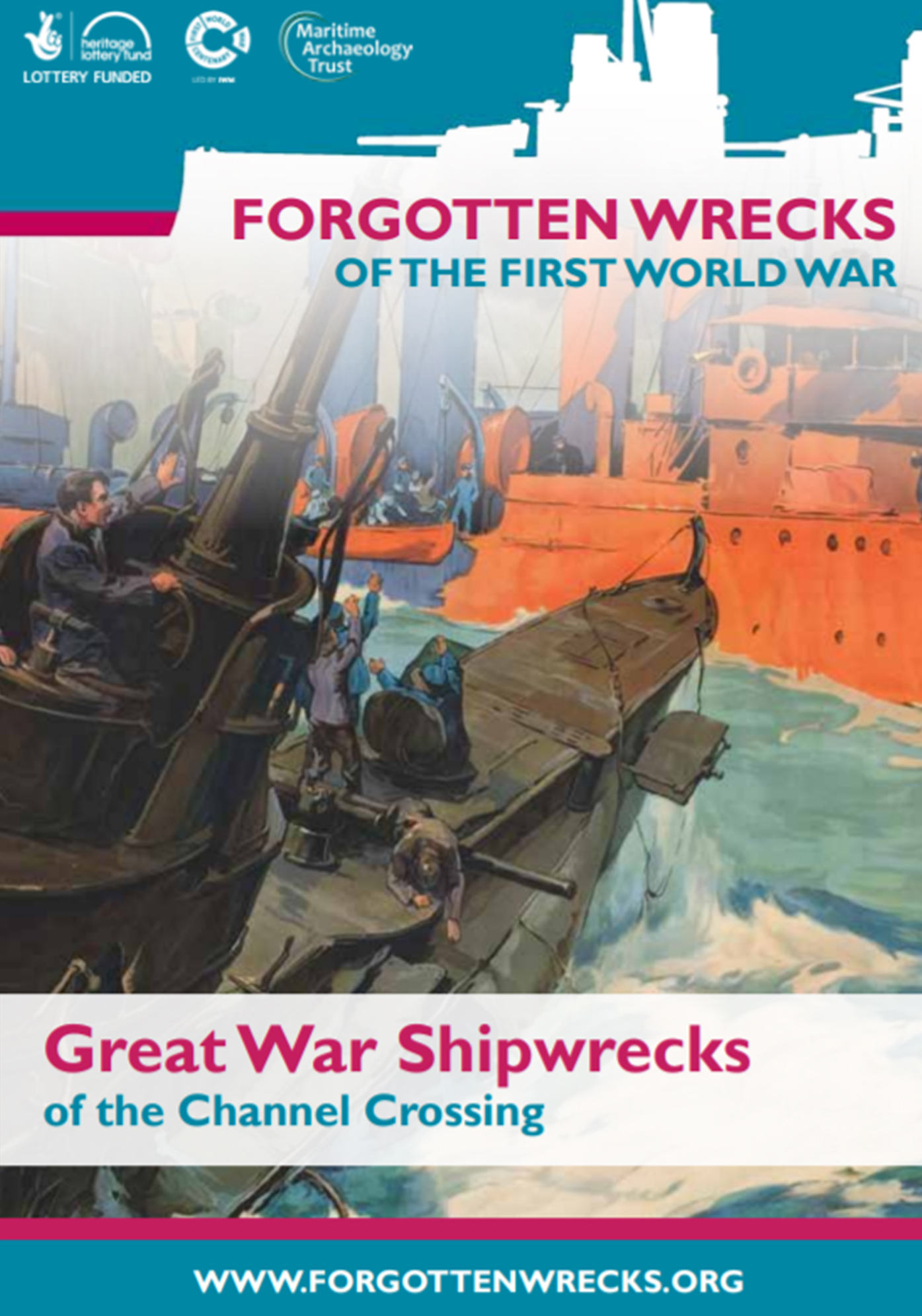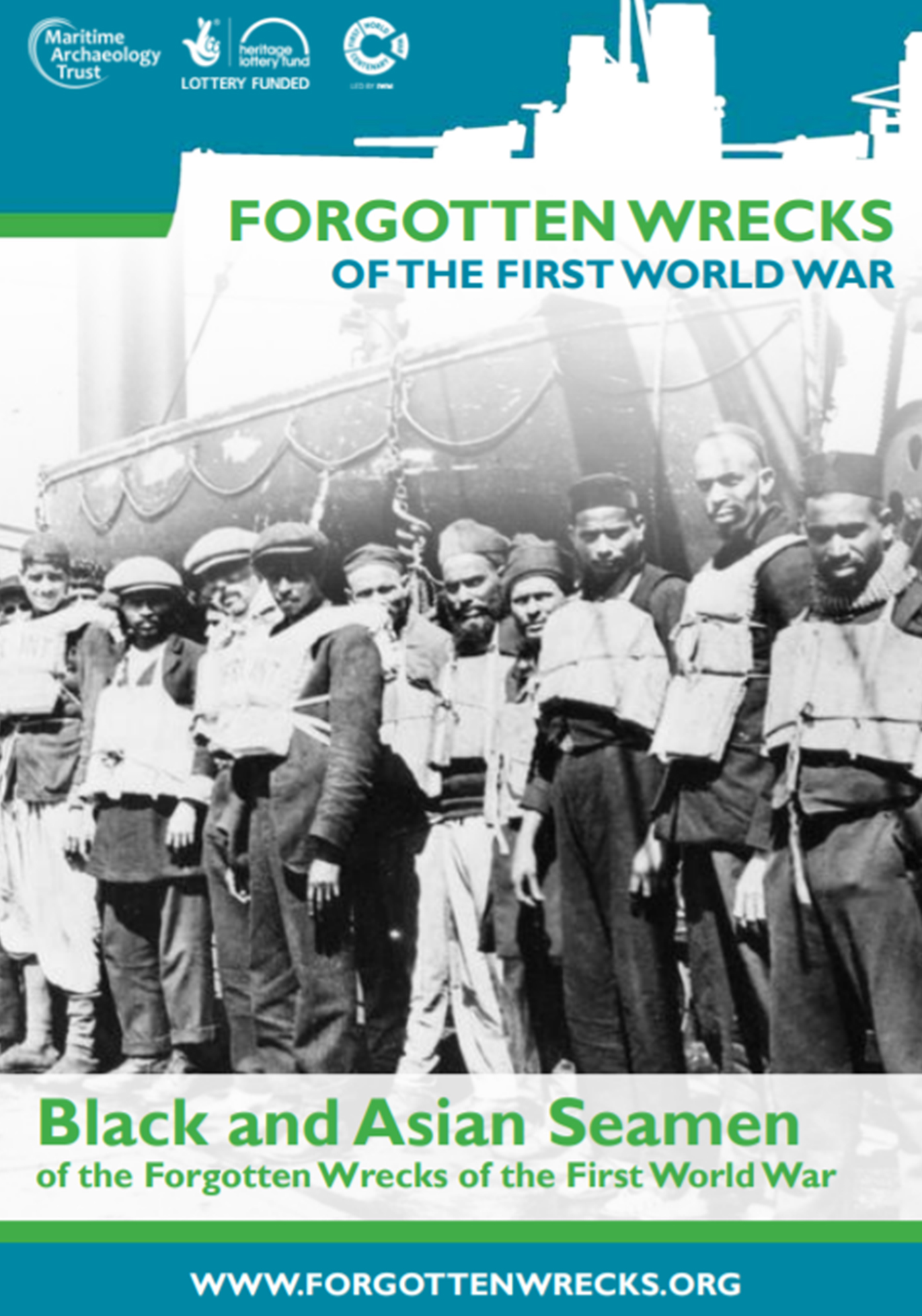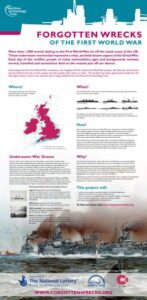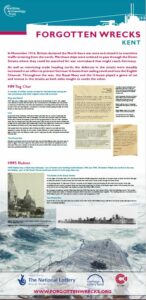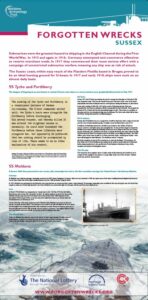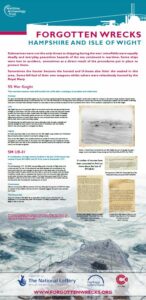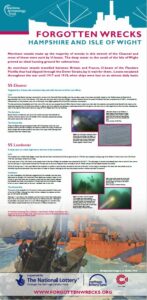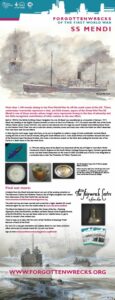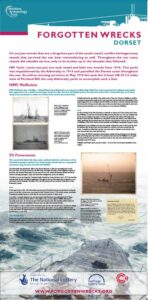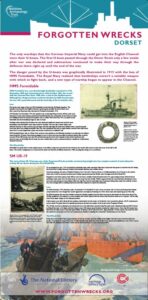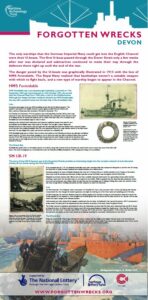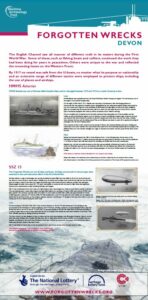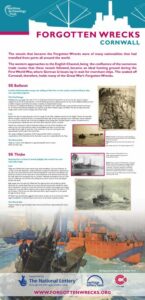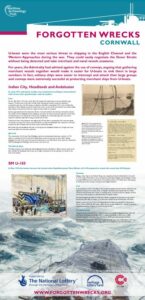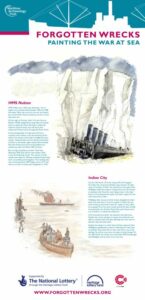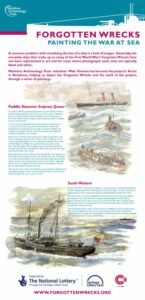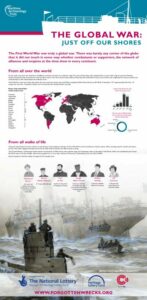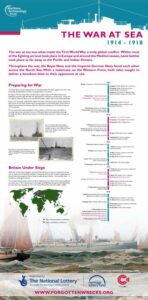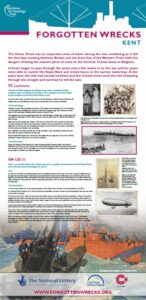The Forgotten Wrecks of the First World War was a Heritage Lottery Funded (HLF) project from 2014-2018, coinciding with the centenary of the Great War.
At the heart of the project was a desire to raise the profile of a currently under-represented aspect of the First World War. While attention is often focused on the Western Front and major naval battles like Jutland, historic remains from the war lie, largely forgotten, in and around our seas, rivers and estuaries. South Coast wreck sites which include merchant and naval ships, passenger, troop and hospital ships, ports, wharfs, buildings and foreshore hulks are often unrecognised and unprotected and have been degrading and deteriorating due to natural and human processes, for approximately 100 years.
As a result they are extremely fragile and in many cases this project represents a final opportunity to record what remains on the seabed and foreshore before it is lost forever. With over 1,100 wartime wrecks along England’s south coast alone, the conflict has left a rich heritage legacy and many associated stories of bravery and sacrifice. These underwater memorials represent the vestiges of a vital, yet little known, struggle that took place on a daily basis, just off our shores.
With the dedicated work of volunteers who have researched, recorded wrecks and artefacts, wrote reports and worked tirelessly, the Maritime Archaeology Trust has transformed this information into educational resources, exhibits to engage the public, videos, talks and presentations, and touring exhibitions at venues across all six of England’s Southern counties. The final result of this project is an accessible database which provides information regarding the shipwrecks, associated finds and additional relative information to provide a lasting legacy of information and learning resources relating to the First World War wrecks for future generations.
The Database
With the dedicated and tireless help of our volunteers, the stories of the 1100 First World War shipwrecks along the south coast of the UK has been brought together for the first time.
For some vessels, details of their whole lives have been readily accessible, captured in official reports, newspapers, personal accounts, and even photographs. Their stories are often tragic, but just as much filled with courage, tenacity, and even, sometimes, a little bit of humour. For other ships, many of the details of the construction and service have gone unrecorded and unremarked. For these vessels, we have gathered what sparse details we can. Their names, at least, will be remembered.
The results of this research are available in our interactive map viewer and database.
Project Elements
Find out more about the various elements of the project:
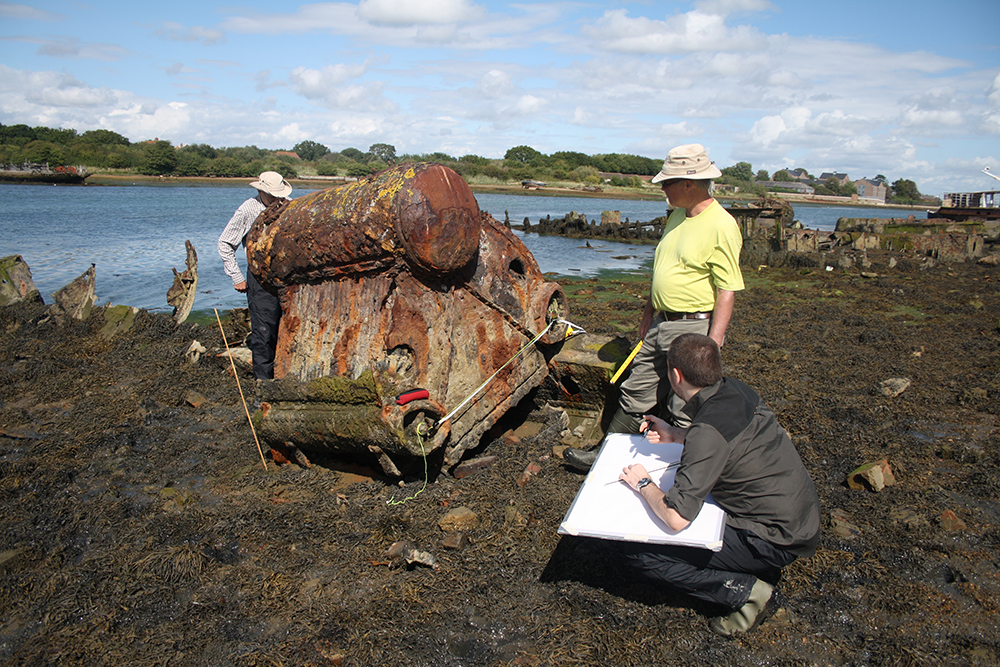
Volunteers were a vital part of the Forgotten Wrecks project, working tirelessly on a huge variety of tasks to help make the project a success.
There were over 1800 days of volunteer work on tasks including:
- Diving
- Planning, contributing to, and delivering outreach sessions and resources, in schools and to the general public
- Research, both online and in the archives
- Writing reports and articles
- Fieldwork and survey (102 events over 62 sites)
- Artefact recording
Some of the more unusual tasks have included setting up geocaches, flying drones, making 2D and 3D models, processing geophysical data, and creating beautiful artworks.
A booklet was produced to thank and celebrate our amazing volunteers, and demonstrates how their efforts make a huge contribution to the work of the Trust.
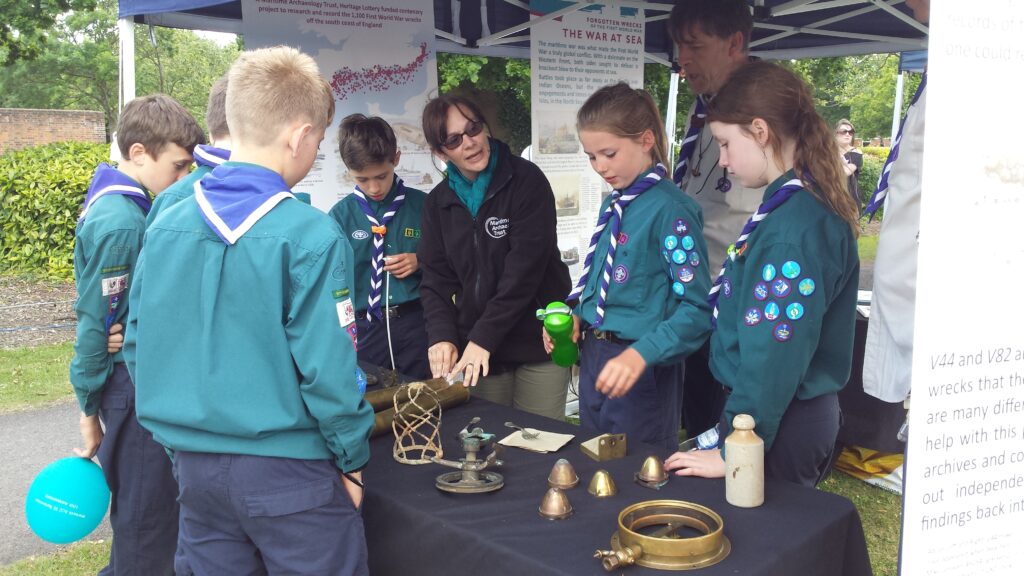
Public engagement has been at the heart of the Forgotten Wrecks project. Though a programm of school sessions, talks, public events and exhibitions, we have reached hundreds of thousands of people to raise the profile of the maritime First World War.
School Sessions, Talks, and Public Events
Through the Forgotten Wrecks project, the following were completed:
- 61 school and youth group sessions with students of all ages, with 2,444 participants
- 8 sessions with special educational need schools and groups
- 8 Heritage Open Days
- 146 public events and 60 talks, reaching over 30,000 people.
If you’d like more information on sessions or talks for your school, group or club, please click here.
See where we went:
Feedback
“Very worthwhile! Even better value as it was free! Not often you get something for nothing! We really liked the way you were able to focus on the SS Shirala. Keep doing what you do.” (Teacher, Rustington Primary School, West Sussex).
“Our Year 1 and Year 2 children really enjoyed the session and retained most of the information- thank you.” (Teacher, East Allington Primary School, Devon).
“[Pupils] really enjoyed it, especially the year 7 and 8. MAT staff were really accommodating and adapted what they were doing for the different groups.” (Teacher, Penryn College, Cornwall).
“Really inspired children who are often difficult to engage in their learning. All the children raving how about fun it was and how much they learned without knowing they were learning!” (Teacher, Bovey Tracey Primary School, Devon).
“The children really enjoyed all the aspects of this visit. The staff were knowledgeable and it was child friendly. I also learnt loads.” (Teacher, Gurnard Primary School, Isle of Wight)
“All year groups thoroughly enjoyed the visit and gained a great deal from it.” (Teacher, Queensgate Primary School, Isle of Wight).
“An excellent session that was well planned to the needs of my class. They wanted longer to explore the bus! We were very impressed with the day and the children took a lot away with them from the visit. They are very interested in the topic and a few of them have since told me that they want to be maritime archaeologists!” (Teacher, Arreton St George’s Primary School, Isle of Wight).
“Jasmine, Steve and Helen were incredibly enthusiastic and accommodating. The expertise and support they provided for the students was brilliant and the students learnt a lot about maritime archaeology, the war at sea and how to use online research and archives. The students were also extremely proud to get involved with an important local/national project.” (Teacher, Upper Shirley High, Southampton).
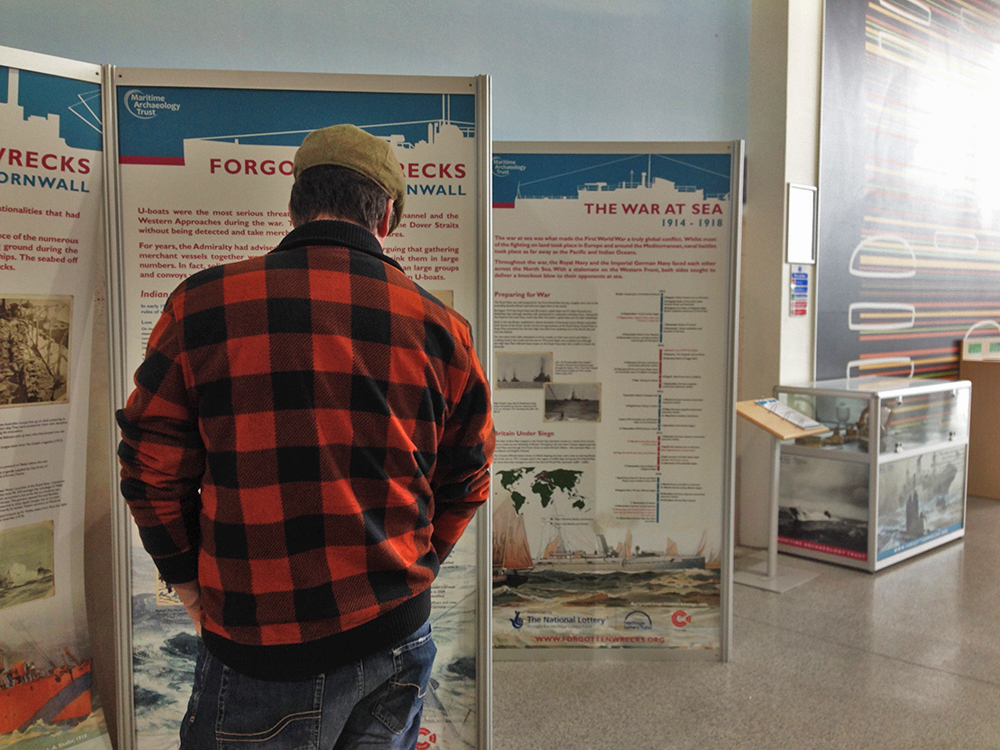
Touring exhibitions on the Forgotten Wrecks project were installed 44 installations across 42 venues in 5 counties between 2014 and 2018, and were seen by over 503,000 people. Each of the south coast counties had a personalised exhibition, with information on wrecks in the local area. Each exhibition comprised three general panels on the project and the maritime First World War, and two county-specific panels, as well as a case of artefacts and, in some venues, a case displaing naval uniforms.
Feedback on the exhibitions includes:
“Very interested to read about HMHS Asturias. I travelled in her replacement, HMT Asturias to Honk Kong from Southampton in 1959.”
“Husband’s grandfather went down with Formidable. Nice to see it remembered.”
“Thanks to the sacrifice of our forefathers we have a future – thanks to [the exhibition] we can see the past.”
See where it went:
Although these exhibitions have now finished, you can still see a version of the panels in the project outputs section below.

One of the aims of the Forgotten Wrecks project was to record the remains of sites and vessels before they are forever lost to time and tide. Work has taken place both on land and underwater, covering everything from shipwrecks to wireless stations. Much of this work has been undertaken by our volunteers- in fact, close to 400 days of volunteer survey and fieldwork took place during the project.
To see the results of this fieldwork, explore our online database of sites and vessels.
Project Outputs
A huge number of outputs and resources were created throughout the project. Click below to find out more:
Here you can see some of the 3D models created by the MAT of First World War artefacts and sites. Click and drag to spin the model round, use the scroll wheel to zoom.
All of these models have been created using a technique called photogrammetry. This method allows measurements to be taken from photographs. Using photogrammetry, 3D models can be created from tiny coins to large buildings. The first step is taking a large number of overlapping photographs of your subject. Once this is done, the photos are then uploaded into a specialist software. This software will then recognise points that appear in multiple photographs which overlap to create a cloud of points that form the shape of the object. You can then create a surface between all the points and layer the original photographs over the point cloud to create a 3D model.
3D models are a great tool used in archaeology as it allows us to explore sites and objects in new and exciting ways, and can be used for both research and education. Sometimes, an object is too delicate to be handled much or needs to be kept in special conditions to help its conservation. By capturing it in 3D, we can create a version of the object that can be virtually handled as much as we need to. 3D models are a great way of viewing an object or artefact when the original is inaccessible, due to its conservation needs, its location in a museum on the other side of the world or because it is still laying on the sea bed. Because of the detail that can be achieved with these models, we can capture information on-site and perform the research back at the office. This is particularly pertinent in maritime archaeology when a lot of what we look at is deep beneath the waves and inaccessible to much of the public.
Volunteer and artist-in-residence Mike Greaves has produced a number of beautiful watercolour paintings of First World War vessels over the course of the project to help tell their forgotten stories.
Mike says , ‘For me, this is a really exciting venture, which has well and truly taken me out of my comfort zone. I try to create an atmosphere from century old black and white pohotographic images. I work with the archaeologists and research the vessels, and the incidents they were involved in, to achieve this.’
Find out more about Mike and see his other artworks at his website, greaves2connections, or see some of his work for the Forgotten Wrecks project below.
What is Geocaching?
Do you enjoy adventure, the outdoors, excitement, searching for the unknown, or just need something to do on the weekend? Then you should check out our geocaching actives! This real-world, outdoor game allows participants to navigate to a specific set of GPS coordinates in an attempt to locate the hidden geocache to trade out goods!
How do I play?
1. Register for a free Geocaching membership.
2. Take a look at the Geocaching Guide.
3. Get ‘caching!
Forgotten Wrecks Geocaches
The port of Southampton was the main embarkation point for the British Expeditionary Force soldiers leaving UK for the western front in France and Flanders at the beginning of 1914. Through this geocache you will discover one of the places that links Southampton with the First World War, specifically the role of Southampton Docks during the war. You will also find out who the ‘Old Contemptibles’ were and why this location is important in their history. This geocache will take you to one of the historical buildings of Southampton: the former Docks’ Post Office and Telegraph building, dating from 1902.
Find out more at:
BBC Radio about the role of the Port of Southampton throughout WW1
Further information about BEF and Beatrix Brice Miller:
Further information about BEF
The War Memorial in the village of Netley Marsh, on the edge of the New Forest, commemorates the 30 men from the Parish who fell in the Great War. Finding this Geocache will allow you to discover the stories of the 7 who were lost at sea.
See also our news article which contains a link to the Geocache listing to get you started!
The location of this cache overlooks the wreck of the British Cargo Steamer SS Ponus. Caught in a storm off the coast of Cornwall in November 1916, The Ponus was driven ashore on Gyllngvase beach where it’s cargo of oil caught fire and burned for three days. Thanks to several daring rescues, all hands were saved.
We are grateful to Cornish Maid and Rudger for creating this Geocache on our behalf, adopting it as the 6th Cache in their Wreck and Rescue series
Find out more at Atlantic Scuba
This cache commemorates the loss of the the WW1 cargo ship SS T.R Thompson which was torpedoed and sank on 29th March 1918, 7 miles South of Newhaven. 33 of the 36 crew onboard were lost, many of whom were Indian (Lascar) sailors.
We are grateful to Nick LostInTheWoods! for creating this Geocache on our behalf, adopting it as the part of his WW1 series:
WW1 Submarine UB-130’s Deck Gun
WW1 Royal Naval Air Station (Newhaven)
WW1 The Gas Chamber at Seaford (Capt. F.A. Varley)
WW1 RIP Willie Elijah Tshabana (East Dean)
WW1 UB-121 Submarine (Birling Gap, Seven Sisters)
Archived, but the web page is still viewable: WW1 RNAS Polegate (Willingdon, Eastbourne)
WW1 CWGC Headstones – DESTROYED (Eastbourne)
WW1 TOC H Plaque (War Memorial, Uckfield)
WW1 German Howitzer (Cranbrook War Memorial)
Hidden away, inside the entrance to Hollybrook Cemetery, opposite Southampton General Hospital is a national First World War memorial few people know about. Yet, it is as important as its famous counterparts like the Menin Gate at Ypres and Thiepval on the Somme. The Hollybrook Memorial was unveiled by the War Graves Commission in 1930. It commemorates by name the members of the Commonwealth land and air forces who were lost or buried at sea or whose final resting place is unknown.
Many of the men and women listed on the 109 panels died when the hospital ships, troop ships or merchant ships they were sailing on were mined or torpedoed, mostly in home waters. Each of the 1,930 people and the twenty-eight ships and two airships named have fascinating and resonant stories to tell – forgotten stories of tragedy, heroism and sacrifice.


